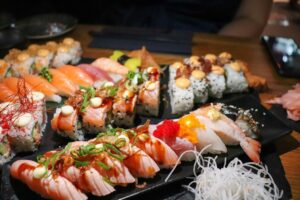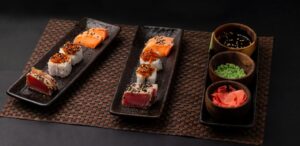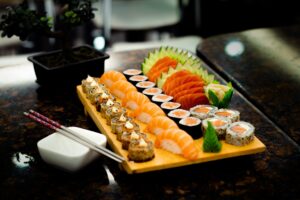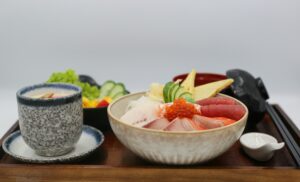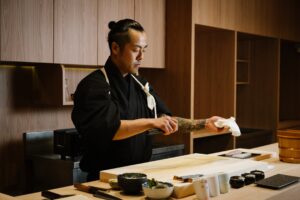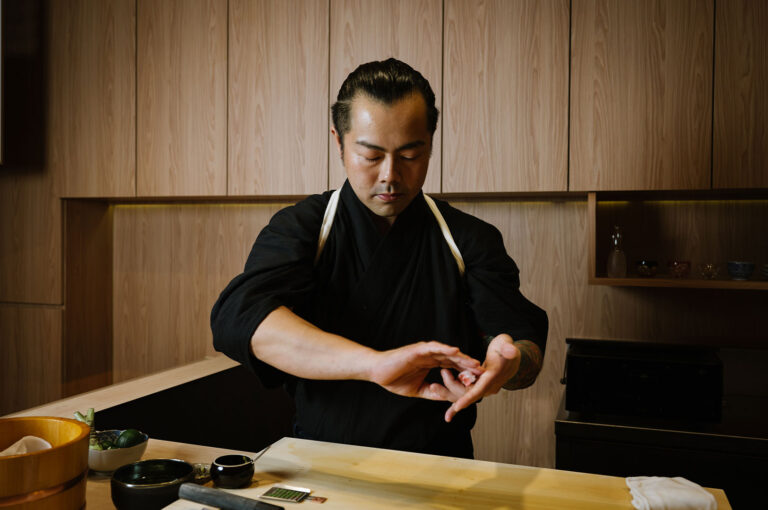
Best Food in Singapore: A Japanese Chef’s Guide to the Lion City’s Culinary Paradise
From our vantage point at Sushi Masa, where Japanese precision meets Singapore’s sophisticated palate, we’ve witnessed firsthand how this remarkable city-state has cultivated one of the world’s most extraordinary food cultures.
Along with Japanese chefs who have dedicated their lives to the pursuit of culinary excellence, we find ourselves continuously inspired by Singapore’s unwavering commitment to ingredient quality, technique mastery, and the preservation of authentic flavors—principles that form the very foundation of our own craft.
Singapore’s culinary scene is a dynamic tapestry renowned for its richness, blending influences from Chinese, Malay, Indian, and other global cultures to create a truly vibrant and unique gastronomic landscape. This scene represents far more than mere sustenance; it embodies a living testament to cultural harmony, where diverse culinary traditions have not only coexisted but flourished together, creating something entirely unique.
This multi-cultural symphony of flavors offers invaluable lessons for any chef seeking to understand how respect for tradition and innovative adaptation can create culinary magic.
If you are looking for unforgettable food experiences, there is no better way to eat in Singapore than by exploring its hawker centers and local specialties.
Singapore’s Food Scene: A Multicultural Symphony Through Japanese Eyes
What strikes us most profoundly about the best food in Singapore is how it mirrors the Japanese philosophy of shokunin—the relentless pursuit of perfection in one’s craft. Whether it’s a hawker stall uncle who has spent decades perfecting his char kway teow or a coffee shop owner who knows exactly how long to steep each cup of kopi, Singapore’s food culture embodies the same dedication to excellence that we bring to our sushi counter each day.
The attention to ingredient sourcing in Singapore parallels our own meticulous selection process at Sushi Masa. Just as we import our fish daily from Toyosu Market multiple times per week, Singapore’s best practitioners source their ingredients with similar devotion—fragrant rice cooked to perfection, fresh seafood selected at dawn, and spices ground daily to maintain their potency.
Singapore’s hawker culture bears remarkable similarities to Japan’s traditional food stall culture, particularly the yatai tradition and modern depachika food courts. Both cultures understand that exceptional food doesn’t require elaborate settings—it requires skill, passion, and unwavering commitment to quality. The communal aspect of hawker centres echoes the Japanese concept of wa (harmony), where diverse people gather to share exceptional food in a spirit of community.
Singapore restaurants are renowned for their reputation and play a vital role in the city’s culinary landscape, offering iconic local dishes and must-visit experiences for both tourists and locals.
What captivates Japanese chefs about Singapore’s food scene is its fearless fusion approach. While maintaining deep respect for traditional techniques, Singaporean cuisine fearlessly adapts and innovates, creating dishes like fish head curry—a creation that would be impossible without cultural openness and culinary creativity. This spirit of respectful innovation resonates deeply with our approach at Sushi Masa, where we honor traditional Edomae techniques while incorporating subtle modern refinements.
Peranakan food is also a prime example of Singapore’s unique blend of Chinese, Malay, and Indonesian influences, showcasing the country’s culinary diversity through traditional recipes and distinctive flavors. It serves as a gateway to experiencing Peranakan culture and history, with notable restaurants offering authentic Peranakan dishes that highlight this rich heritage, creating something entirely unique.
The Heart of Singapore Dining: Hawker Centers and Food Courts
Understanding the hawker center culture requires appreciating its remarkable parallels to Japanese food systems. We see this mirrored in our own food scene, particularly in the structure of depachika food courts, where multiple specialist vendors operate under one roof, each maintaining their own demanding standards of excellence. However, Singapore’s hawker centres possess a democratic accessibility that makes exceptional, honest food available to everyone—a principle we deeply admire.

Insights from Singapore’s Iconic Food Halls
Maxwell Food Centre stands as perhaps Singapore’s most iconic hawker destination, where legendary stalls like Tian Tian Hainanese Chicken Rice have achieved international recognition. This food centre is a must-visit destination for anyone seeking authentic local flavors and a true taste of Singapore’s culinary heritage.
The center operates with the precision of a well-orchestrated kitchen, where each stall specializes in specific dishes, perfecting their craft over generations. We appreciate how this specialization mirrors our Chef Masa’s own focus on sushi mastery—depth over breadth, pursuing perfection over mere variety.
Newton Food Centre and Old Airport Road Food Centre each offer their own distinct characters, much like different neighborhoods in Tokyo maintain unique food identities. Newton caters more to tourists seeking classic dishes like satay and chili crab, while Old Airport Road serves as a local institution where families have operated beloved dishes for decades. Both are home to some of the best hawker stalls in Singapore, renowned for their quality and long-standing reputations among locals and visitors alike.
The Shared Art of Culinary Respect
Navigating hawker centers requires understanding their unspoken protocols—claiming tables with tissue packets, ordering from multiple stalls, and the art of communal dining where strangers become temporary neighbors. This differs significantly from Japanese dining culture, where individual space is often paramount, yet both cultures share deep respect for the food preparation process and the craftspeople behind each dish.
The communal aspect of hawker center dining creates a unique, vibrant energy that we’ve tried to capture in our own restaurant design. While Sushi Masa offers intimate omakase experiences, we’ve incorporated communal elements, like our counter seating, that encourage dialogue and shared appreciation for culinary artistry—lessons learned from the warmth and genuine interaction found in Singapore’s incredible food courts.

Singapore’s Signature Dishes: Must-Try Culinary Icons
Hainanese Chicken Rice - Singapore’s National Dish
As practitioners of precise cooking techniques, we deeply admire the mastery required to execute perfect Hainanese chicken rice. This dish embodies principles fundamental to Japanese cuisine: respect for ingredients, precise timing, and transforming simple elements into something transcendent.
The chicken is poached at exactly the right temperature to maintain its silky texture, mirroring the temperature control used in sushi preparation. The rice, cooked in chicken fat, gains richness and a slightly oily texture, resulting in flavorful rice that perfectly complements the tender chicken. The fragrant rice cooked in chicken stock, garlic, and ginger requires the same attention to grain selection and technique as sushi rice, demonstrating how properly prepared rice can transform a meal.
The accompaniments—ginger paste, chili sauce, and dark soy sauce—enhance rather than mask the chicken’s natural flavor, reflecting the Japanese principle of highlighting ingredient quality without overwhelming it. These elements provide textural and flavor contrasts that elevate the dish while maintaining restraint in seasoning, showcasing the balance and finesse that define Singapore’s food culture and its best food in Singapore offerings.
Chili Crab - The King of Singapore Seafood
The selection and handling of fresh seafood for chili crab demonstrates principles we hold sacred in Japanese cuisine. The crabs must be alive and active when selected, their shells bright and clean—standards identical to those we apply when selecting sea urchin or premium fish for our omakase menu.
While chili crab is celebrated for its sweet, spicy, and tangy sauce, black pepper crab stands as another iconic Singaporean seafood dish, renowned for its bold black pepper seasoning and robust flavor profile. Both chili crab and black pepper crab are must-try delicacies, each offering a unique taste experience and holding a special place among local favorites.
The chili crab sauce represents a masterclass in balance. This complexity reminds us of creating the perfect sushi rice seasoning, where rice vinegar, sugar, and salt must be balanced to enhance rather than compete with the fish. The sauce’s texture—thick enough to coat but not so heavy as to overwhelm—requires the same technical precision we bring to our house-made soy sauce blends.
What resonates most with our Japanese sensibilities is the seasonal approach to crab selection. Just as we adjust our fish selection based on seasonal availability and peak quality periods, the best chili crab restaurants modify their sourcing throughout the year to ensure optimal crab quality.
Laksa - The Perfect Fusion Bowl
Laksa exemplifies Singapore’s multicultural identity through its seamless blending of Chinese noodle techniques and Malay spice traditions. We appreciate the technical complexity required to create laksa’s distinctive coconut milk base, as we work with both ramen and specialized broths.
The key to laksa’s appeal is its flavorful broth, which shares similarities with our dashi-making process—both require patience, precise timing, and deep understanding of how different ingredients contribute to the final flavor profile. The coconut milk must be heated carefully to prevent curdling, while the spice paste requires proper aromatics development through controlled heat application.
A traditional topping that enhances both the flavor and authenticity of laksa is fish cake, which adds a unique texture and savory note to the dish.
Laksa is a perfect example of the best food in Singapore, showcasing the city’s rich food culture through its blend of Chinese and Malay influences. This dish’s complexity and balance highlight the dedication to ingredient quality and technique mastery that defines Singapore’s culinary scene. The careful preparation of fragrant rice noodles and the harmonious combination of coconut milk and spices create a comforting yet vibrant flavor profile.
Noodle Mastery: Singapore’s Asian Noodle Culture
Char Kway Teow - The Wok Hei Champion
Understanding wok hei—the “breath of wok”—requires appreciating one of Asian cuisine’s most elusive and technically demanding concepts. As professionals experienced with high-heat cooking techniques like teppanyaki, we recognize the mastery needed to achieve the distinctive smoky flavor that only comes from perfect timing and intense heat. In dishes like char kway teow, this is accomplished through expert stir frying, a technique that quickly fries ingredients in a hot wok to develop the dish’s signature flavor and texture.
Dishes like char kway teow are renowned as filling meals, offering hearty satisfaction and nutritional value. The flat rice noodles must be handled with the same precision as our fish preparation; overcooking leads to mushiness, while undercooking results in toughness and poor flavor absorption. The key ingredients—dark soy sauce, blood cockles, Chinese sausage, and bean sprouts—are added in precise sequence to build progressive layers of flavor, mirroring our philosophy of creating harmonious sushi where every element enhances the core ingredient.
Bak Chor Mee and Wanton Mee
Singapore’s noodle culture offers fascinating parallels to Japanese ramen traditions, particularly in the attention paid to noodle texture and broth development. Bak chor mee and wanton mee represent distinctly Singaporean interpretations of Chinese noodle traditions, adapted over generations to local tastes and available ingredients.
The egg noodles used in these dishes require specific preparation techniques to achieve the proper springiness. The noodles must retain structure while absorbing the seasoning mixture of vinegar, chili sauce, and lard, balancing firmness and flavor absorption with the same technical understanding applied to rice preparation.
The minced pork topping in bak chor mee demonstrates how simple ingredients can be elevated through proper technique. The pork must be cooked to maintain texture while developing complex flavors through careful seasoning and controlled cooking. This attention to texture and seasoning resonates with our approach to preparing fish for nigiri—simple techniques executed with precision.
Rice Culture: From Nasi Lemak to Claypot Creations
The importance of rice in Singapore cuisine mirrors its central role in Japanese food culture, where rice quality and preparation techniques fundamentally determine meal success.
Nasi lemak’s fragrant coconut rice shares philosophical similarities with our takikomi gohan (seasoned rice dishes), where the rice absorbs complementary flavors while maintaining its essential character. Many top versions of nasi lemak use basmati rice for its aromatic and fluffy qualities, elevating the dining experience. The coconut milk must be carefully incorporated to create fragrant rice without overwhelming the grain’s natural texture, requiring attention to liquid ratios and cooking temperatures similar to sushi rice preparation. Popular accompaniments and toppings for nasi lemak include fried chicken, fried fish, beef rendang, and roasted peanuts, each adding unique flavors and textures that are integral to the dish.

Claypot rice preparation offers parallels to Japanese kamameshi (pot rice) cooking methods, using specific vessels to create distinctive textures and flavors through controlled heat. The crispy bottom layer, fan jiow, requires precise timing and heat control, akin to achieving perfect rice texture in traditional sushi tubs. Glutinous rice is also a key ingredient in many traditional rice-based dishes and desserts in Singapore, valued for its sticky texture and versatility.
Street Food and Snacks: Singapore’s Culinary Soul
Satay and Grilled Specialties
The grilling techniques used for satay demonstrate principles fundamental to Japanese yakitori preparation—direct heat control, proper marination timing, and understanding how different proteins respond to high-temperature cooking. Both traditions emphasize consistent heat application and careful attention to cooking progression.
The marination process requires patience to develop deep flavors without overpowering the meat’s natural characteristics, aligning with our philosophy of fish preparation, where aging and light curing enhance umami without masking essential tastes.
The peanut sauce accompanying satay is a complex blend of elements, requiring precise balance and a consistency that complements rather than overwhelms the grilled meat. Satay vendors’ individual mastery in skewer preparation, marination, and heat control reflects the same shokunin dedication that drives daily improvement in sushi preparation.
Roti prata preparation involves hand-pulled dough techniques that require manual dexterity, timing precision, and gluten development knowledge, reminiscent of Japanese noodle-making skills. The dough is stretched to thinness and cooked on a flat griddle with controlled oil application to achieve a crispy exterior and tender interior.
Morning Traditions: Singapore’s Breakfast Culture
The parallels between kopitiam culture and traditional Japanese kissaten coffee shop traditions reveal shared values around unhurried morning meals and community gathering spaces.
Kaya preparation requires the same attention to texture and flavor development that we apply to our seasonal preparations. The coconut jam must achieve proper consistency through careful cooking and stirring, while the egg and sugar ratios must be precisely balanced. This technical precision in seemingly simple preparations reflects values we hold dear in Japanese cuisine. The soft boiled eggs accompanying kaya toast require exact timing to achieve proper texture—runny yolks with just-set whites.
This precision cooking mirrors the attention we pay to temperature control in our fish preparations, where seconds can determine success or failure. The eggs typically served alongside must be perfectly executed to complement the sweet kaya and crispy bread. A variety of beverages are enjoyed with this breakfast, and sweet milk tea—such as teh tarik—is a popular choice, offering a creamy and aromatic complement to the meal.

Sweet Endings: Desserts and Refreshments
Singapore’s dessert culture offers cooling relief from tropical heat while showcasing traditional techniques passed down through generations. Ice kachang and other shaved ice desserts demonstrate precision in texture creation and flavor layering that aligns with Japanese attention to seasonal and textural variety.
These desserts are often topped with sweet syrup, enhancing their flavor and adding a nostalgic touch reminiscent of authentic local treats. The technique required to create proper shaved ice texture—fine enough to absorb flavors while maintaining structural integrity—requires equipment mastery and timing precision, resonating with our own focus on ice preparation and temperature control throughout the dining experience.
Traditional kuehs (rice cakes) showcase steaming and preparation techniques that parallel Japanese wagashi confectionery traditions, demonstrating how simple ingredients like rice flour can be transformed into diverse textures and presentations through careful technique.
Durian, Singapore’s most polarizing fruit, represents an acquired taste culture similar to Japan’s appreciation for foods like fermented soybeans or sea urchin. Its intense and complex flavor profile requires cultivation and understanding, aligning with sophisticated palate development encouraged in Japanese cuisine appreciation.
Beverages: From Kopi to Singapore Sling
Local coffee culture reveals a sophisticated appreciation for preparation techniques and flavor development that parallels Japanese attention to beverage craftsmanship. The traditional kopi and teh preparations use specific ratios and methods to create distinctive flavor profiles that complement Singapore’s food culture. The addition of condensed milk and sugar is carefully balanced to enhance the coffee’s essential character, reflecting a similar dedication found in sake and tea pairings.
Fresh tropical juices showcase Singapore’s abundant fruit varieties, with precise preparation and serving techniques that preserve natural flavors and nutritional content.
Understanding how beverage pairings enhance Asian cuisine offers valuable insights for menu development, demonstrating how traditional drinks complement the spicy, sweet, and savory flavors of Singapore’s best food. These lessons are applicable to omakase beverage pairings, emphasizing the harmony between drinks and cuisine.
Endless Delicious Dishes: Time to Eat in Singapore
After years of exploring Singapore’s extraordinary food landscape, we’ve gained a profound appreciation for how this city-state approaches culinary excellence. Singapore teaches invaluable lessons about respecting culinary traditions while embracing innovation—a balance that requires deep cultural understanding and creative courage. Whether in a hawker stall or fine-dining establishment, the best food in Singapore consistently reflects a commitment to excellence that transcends economic considerations, resonating deeply with our philosophy at Sushi Masa.
The multicultural harmony achieved in Singapore cuisine inspires our own creative development. Just as Singapore integrates diverse culinary traditions while maintaining authenticity, we strive to honor traditional Edomae techniques while incorporating subtle innovations that reflect our Singapore location and clientele.
The technical precision required for Singapore’s signature dishes has influenced our commitment to consistency and quality control. Observing hawker stall masters maintain exacting standards despite high-volume service reinforces our dedication to never compromising quality for efficiency. Most importantly, Singapore’s food scene shows how passion and dedication create exceptional experiences regardless of scale or setting—a spirit we bring to every aspect of Sushi Masa, from daily fish selection to guest interactions.
Experience this same dedication to ingredient quality and culinary artistry at Sushi Masa, where we apply Japanese precision and seasonal awareness to create unforgettable omakase experiences. Chef Masa brings the same passion for excellence that drives Singapore’s finest food culture, combined with traditional Japanese techniques refined over generations.
Ready to experience Singapore’s finest Japanese cuisine? Reserve your best omakase experience at Sushi Masa and discover how traditional Japanese techniques and Singapore’s exceptional ingredients create something truly extraordinary. Contact us today to begin your culinary journey.

